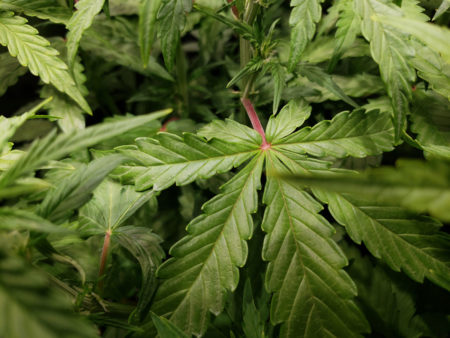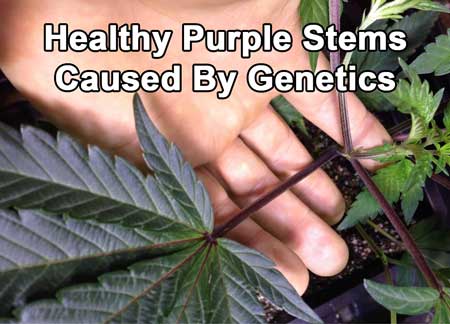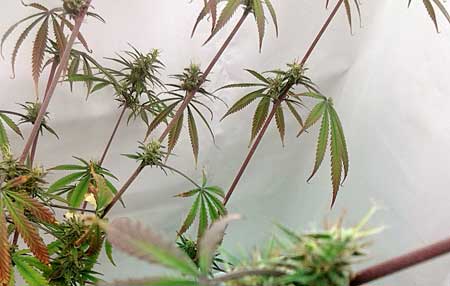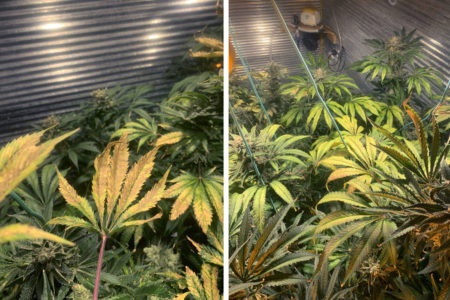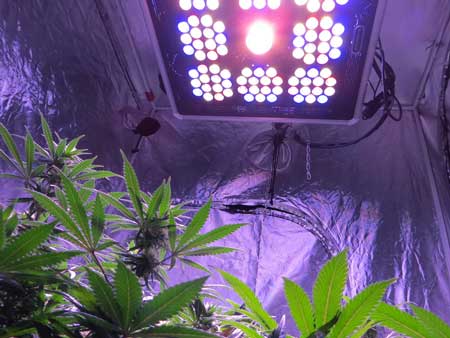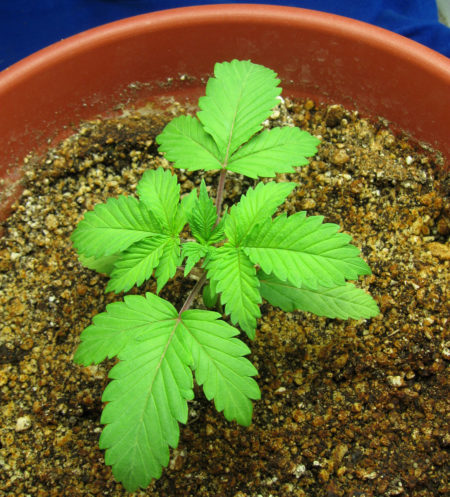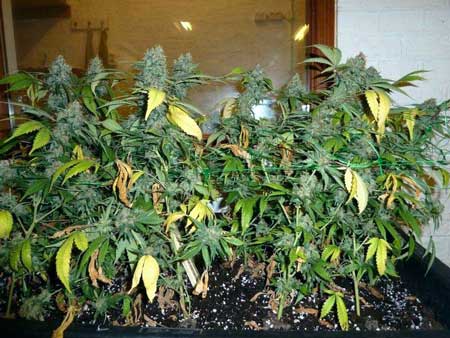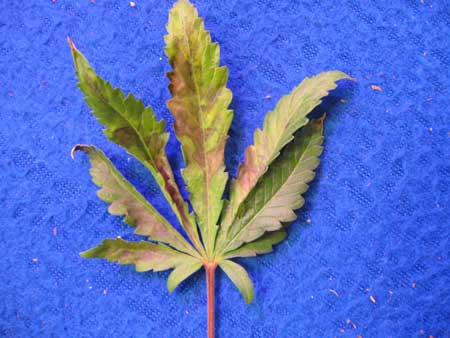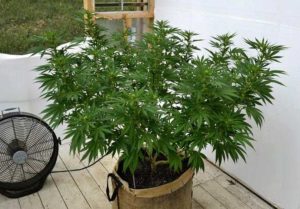by Nebula Haze
You’re checking on your plants, things have been going pretty well. Then one day you notice a plant has bright red stems. Maybe there are other symptoms, too, like burnt leaf edges/tips, clawing/curling leaves, or yellowing.
A common cannabis plant symptom is red stems. What does it mean?
You love your plants, so what do you do? What causes a cannabis plant’s stems to turn red or purple?
There are a few different causes of red stems so I’ll share the most common ones below. Once you go through this list, you’ll be armed with more information to help keep your plants healthy and happy. Get the great yields and amazing bud quality you’re looking for.
Here are 6 common causes of red stems in cannabis plants:
1.) A “Sun Tan”
If a stem is totally exposed to strong direct light, it will often turn red, pink, or purple over time. If this is the cause, you’ll likely notice that any parts of the stem that are in shade will stay green. This is a defense mechanism by the plant to protect the stems from too much light. This type of red coloring is especially common with grow lights the produce a lot of UV light such as LEC grow lights (bonus: those same UV rays increase trichome production!).
With the rise of plant training techniques that expose bare stems, such as manifolding or defoliation, red stems caused by direct light is more common than ever.
In this case, you probably have nothing to worry about as long as you aren’t seeing any other symptoms and plants are growing fast and healthy.
This video shows how the stems/petioles lower in the plant are the typical green color. However, if you look closely at the stems higher on the plants, the tops have turned red wherever they get direct exposure to light. Light exposure can be a major contributor to red stems.
2.) Genetics
Some plants (especially strains that produce purple buds or leaves) will naturally grow colorful stems. These stems may be perceived as “red”, though typically look closer to purple than bright red. In this case, the purple color appears on stems all over the plant as opposed to just places that are getting light. There’s nothing to worry about in this situation, so you can just enjoy the pop of color 🙂
3.) Temperature Fluctuations
Hot days and/or cold nights can trigger purple or reddish stems and leaves. If the discoloration appears the day after a cold night, the quick change in temperature may have caused the colorful stems. Typically temperature fluctuations cause stems to look purple, but sometimes the color can appear reddish.
These stems turned reddish-purple in response to cold night temperatures
4.) Plant Stress
Cannabis plants react to stress in unpredictable ways. It may seem odd, but sometimes discolored stems are caused by seemingly unrelated factors like overwatering, bugs, or heat. That’s why it’s important to pay close attention to plants, use good watering practices and maintain a great growing environment when cultivating cannabis.
Learn how to water cannabis plants. For hydroponic growers, learn how to keep roots healthy. And watch out for bugs!
Many different types of plant stress can cause red stems. This plant with red stems looks like it is suffering from a nutrient deficiency, but the real cause of the symptoms is a planthopper infestation.
If the temperature of your growing environment seems extreme to you, it may be stressing out your plants. Each strain is different, but cannabis plants generally grow best in temperatures that are considered comfortable or slightly warm to humans. You should be able to put a hand where your plants are under the light and hold it there comfortably for 30 seconds. If it feels too hot for your skin, it’s likely too much heat for your plants. Learn how to create a perfect plant environment.
Red stems can also be triggered by keeping a grow light too close to the plants. Regardless of the temperature! Some strains are more sensitive to light stress than others, but just about all plants have a limit when it comes to light levels. It may be surprising, but a plant can experience stress from the light intensity even if the temperature is cool, similar to how a snowboarder can still get sunburned in the cold.
Since too much light can cause red stems and other symptoms of stress, it’s always a good idea to keep your grow lights at the distance recommended by the grow light manufacturer. LED grow lights especially are infamous for light-burning plants if kept too close (it’s common for growers to keep moving them closer since they run cool).
Keep grow lights the recommended distance away to avoid symptoms from light stress
5.) Nutrient Deficiency Caused by Lack of Nutrients
If you look at your plant and you’re noticing that it’s pale all over, in addition to the red stems, that’s a sign your plant may simply need higher levels of nutrients overall. This is especially common if a plant has stayed in the same plant container for a long time without getting extra nutrients. If you’re growing in an inert soilless medium like coco, you may be giving too-low levels of nutrients. If you’re in a hard-sided pot, it’s also possible your plant is rootbound as opposed to out of nutrients, which means you should transplant to fresh soil. If you’ve been giving your plant nutrients in the water, this probably doesn’t apply to you, so skip to the next step.
The overall pale color alongside the red stems means this plant needs higher levels of nutrients overall. Grown in coco coir (which doesn’t naturally contain any nutrients), this grower needs to give higher levels of nutrients in the water.
Cannabis plants use high levels of nutrients compared to a lot of house plants, so growers typically add nutrients as part of the growing process. However, there are a few styles of growing cannabis that don’t require the use of extra nutrients at all.
For example, you can grow plants from seed to harvest in a big pot of richly amended, freshly composted (“alive”) soil that’s been formulated for a plant like cannabis. This technique works by providing nutrients via a method similar to nature. The composted soil contains a colony of microorganisms that break down organic material into nutrients, which your plant can use over the course of months. Known as a “just add water” grow method.
Where to get “just add water” soil? I recommend Nature’s Living Soil for a premade “Super Soil” concentrate. I’ve found them to be a great company that stands behind their product and they happily answer questions about how to use their concentrate for growing cannabis. Add it to regular soil or coco and the organic sources of nutrients slowly break down over months. If you follow instructions, you shouldn’t need to add nutrients in the water from seed to harvest.
These plants were started in nutrient-rich soil, but they used all the nutrients up before harvest. This caused the yellowing leaves and red stems.
If your plants have been growing in the same pot for a while, it’s possible all the nutrients in the soil have been used up (even if you started them off in richly amended super soil). Or perhaps the soil originally didn’t contain high enough amounts of phosphorus and magnesium, which can trigger red stems. In either case, if you suspect your plant is just low on nutrients, the best option is to supplement your plant with extra nutrients. Even if you’re growing organically, there are natural sources of nutrients that can be added to hold your plant over and make sure it’s getting complete nutrition until harvest. Make sure to use nutrients formulated for cannabis, because complete nutrition ensures the biggest, best and stickiest buds!
Learn more about suitable cannabis nutrients
If you’ve been giving your plants good nutrients and ruled out all the above factors, your red stems are likely caused by a…
6.) Nutrient Deficiency Caused by the Wrong PH
Is your pH too high or low? If you’ve ruled out all the above triggers, there’s a strong chance the red stems are a sign your plant has a pH-based nutrient deficiency (or the beginning of one). Nutrient deficiencies that can affect red stems include Magnesium deficiencies and Phosphorus deficiencies. If you’ve been giving your plants nutrients, these deficiencies are typically caused by incorrect pH.
A nutrient deficiency is especially likely if your stems are bright red (not purple) all over the plant, and the coloring doesn’t seem affected by light exposure. You may also see other symptoms of deficiencies such as brown edges, curling leaves, burnt tips, yellowing, and more. Luckily, nutrient deficiencies caused by incorrect pH are easy to get rid of.
Red stems can be caused by nutrient deficiencies caused by too-high or too-low pH. This leaf is suffering from multiple problems including red stems.
Growers like to skip over testing the pH of water because it doesn’t seem glamorous, but I think of adjusting pH like a supplement that makes plants grow better. Plants grow faster and healthier when they get the right pH. Even when using “PH Perfect” nutrients or “Super soil” (which provide a buffer against pH-based nutrient deficiencies), it’s still possible to experience problems if the pH gets too out of whack. Don’t skip this step if you’re experiencing problems with your plants!
How to Test and Adjust the PH (full pH tutorial)
- Add all your nutrients and supplements to your water (if you’re using any)
- Test the pH of your water before giving it to your plants
- Option 1: Test pH with drops (included in most basic PH Test Kits) that change color and get compared to a color chart
- Option 2: Use a digital PH Pen which will give you a precise number reading (I love this PH Pen but there are cheaper options that get the job done)
- PH of water should be between…
- Soil: 6-7 pH
- Coco or Hydro: 5.5-6.5 pH
- If the pH is too high or low, adjust it to the proper range before giving the water to the plants (a PH test kit has liquids that adjust the pH of water)
- Water your plants with your freshly pH’ed water
- If you’re still experiencing nutrient problems, test the pH of the runoff water (collect a sample of the runoff water that comes out the bottom and test the pH of that too)
- If the runoff pH is too high or low (even though you put the water in at the right range) it means something in the grow medium is affecting the pH.
- The gentle way to fix this is to give your plant water from the opposite end of the pH range at every watering until the runoff starts coming out in the proper pH range. This will change the pH slowly over time.
- If there’s an extreme deficiency with lots of symptoms, you might want to actually “flush” the plant by running water through it until the pH comes out in the right range. This removes extra “stuff” that may have been affecting the pH, and basically gives you a blank slate. Flushing in this way is well suited to growing in coco, but isn’t a good choice in soil unless you’re replacing the lost nutrients by giving additional nutrients in the water. You don’t want to flush out all the nutrition without replacing it. Learn more about flushing sick plants.
How to adjust pH?
Luckily this is easy. Use a bottle of “PH Down” in order to bring the pH down, and “PH Up” to raise it. Both are included with a basic PH test kit.
These are strong liquid supplements that can be added directly to the water to adjust the pH. Use a small amount of liquid to start, just a 1/8 tsp or a few mL (PH Down is especially concentrated). There is also Natural PH Down and Natural PH Up which are suitable for use in organic setups.
A standard PH Test Kit has everything you need to test and adjust pH
What exactly is pH?
PH is a scale that measures how basic or acidic a water-based solution is. It’s typically shared as a number between 1-14. Pure room-temperature water is considered neutral and has a pH of ~7.
Why does pH matter to cannabis growers?
Managing the pH is the #1 way to prevent nutrient deficiencies. PH is important to cannabis growers because pH has a huge effect on nutrient absorption. Keeping your water at the right pH for the type of plant and growing medium allows your plant to absorb nutrients quickly and easily.
Cannabis plants typically grow faster and healthier at the recommended pH
How exactly does pH affect nutrient absorption?
A plant’s roots have the remarkable ability to absorb nutrients from the soil and use them inside the plant. This is accomplished with a complex series of processes, but just to keep things simple for the sake of explaining why pH matters, imagine there are “holes” in the roots that let nutrients in. Now imagine those holes are shaped like circles. When the pH at the roots is in the right range, the nutrients take on the form of circles, which easily pass through the holes into the plant. However, if the pH is too high or low, it actually changes the physical structure of the nutrient molecules. It turns the nutrient molecules into other shapes, for example squares. These squares have a much harder time passing through the round holes. Your plants won’t be able to absorb the nutrients (even though they’re physically “there”) and as a result your plant will experience nutrient deficiencies.
Check Out the Complete PH Tutorial
This tutorial covers every cause of red stems I’ve learned about since I started growing in 2008, but like every article on this website, we’re always adding and updating as we learn more. If you’re still experiencing red stems after going through the above steps, we want to hear from you! Don’t hesitate to contact us with pictures and info. Just say you read this article and we’ll take a look 🙂

